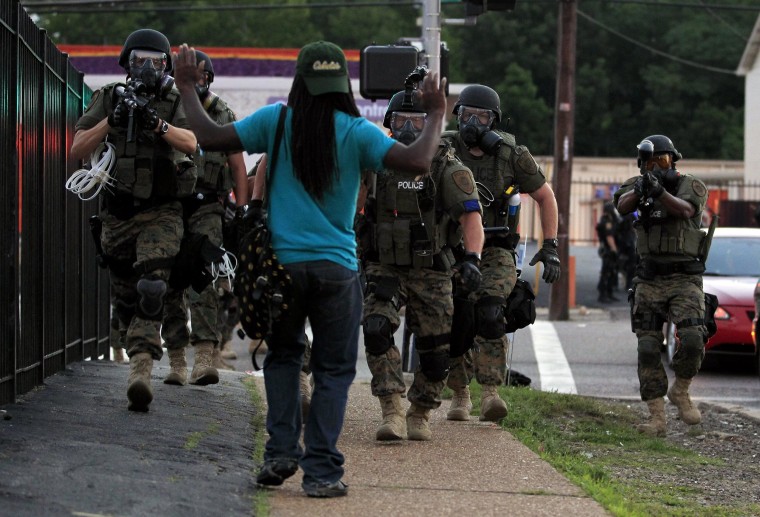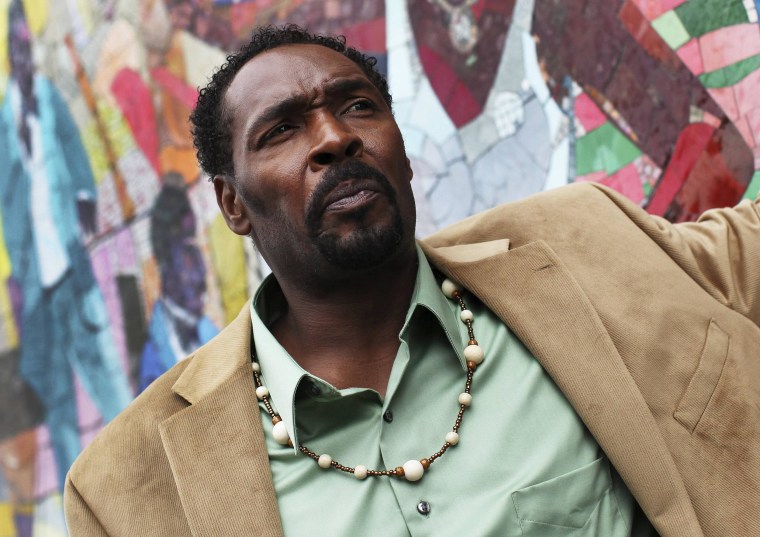The Los Angeles Police Department’s response to the Rodney King riots 22 years ago could provide a blueprint for what happens in the coming months and years in Ferguson, Missouri, as police work to repair their reputation in the wake of Michael Brown’s fatal shooting, according to experts on the LAPD’s transformation.
After four police officers beat King but were acquitted of assault, L.A. erupted into riots that claimed 53 lives. At the time, the non-white residents of the country’s second biggest city saw the LAPD as “an occupying army .. as opposed to a police force,” said Jeff Schlanger, a security expert who was appointed as an independent monitor in 2001 to help reform the department and determine if it discriminated against minorities.
But the LAPD was able to transform itself with the help of the federal government – which is now investigating police actions in Ferguson – and a new police chief.
Though the 53-member Ferguson police force and the 10,000-officer LAPD are in some ways as different as two departments can be, after high profile violent incidents both came to symbolize racial division. And both, said Schlanger, had lost the trust of the people they served.
“If the trust existed when (Brown) was shot, the events that occurred subsequent likely would not have occurred,” Schlanger said, referring to the unrest that rocked Ferguson after Brown’s shooting on Aug. 9. “There would have been trust … that the system would work.”
Connie Rice, a civil rights attorney from Los Angeles, also sees echoes of the LAPD’s failures more than 20 years ago in Ferguson.
“Now these officers (in Ferguson) have lost all validity and all ability to persuade this population to comply with the law or with their commands,” she told NBC News last month. “And once you reach that point of no return, you have to take drastic action. You have to start over, and fast.”

Attorney General Eric Holder said on Thursday that rebuilding that trust will be paramount, in a statement announcing a Justice Department investigation of law enforcement in Ferguson.
“While there is much work left to do, we feel confident that there are solutions to any issues we find and that community trust in law enforcement can be restored and maintained,” he said. “Ferguson and St. Louis County are not the first places that we have become engaged to ensure fair and equitable policing and they will not be the last.”
While the LAPD still faces scrutiny over the even-handedness of its enforcement of the law — it is currently investigating the officer-involved shooting of a mentally challenged black man last month — Schlanger said the department today is “a far cry” from the one that came under scrutiny after the videotaped beating of King, an African American, in March 1991 by four white LAPD officers.
The LAPD officers were charged with assault with a deadly weapon and use of excessive force after the shocking images of King’s beating were broadcast around the world. When the officers were acquitted of all criminal charges in April 1992, racial tensions boiled over, leading to days of deadly rioting in Los Angeles.
Then, as now, intervention by the federal government served as a catalyst for change. By May 2000, the U.S. Department of Justice was prepared to sue Los Angeles over what it said was a pattern of police misconduct. Instead, the city and police department signed a consent decree, which allowed federal authorities to oversee the LAPD as it implemented new policies and practices.
Schlanger, who currently works in the New York County District Attorney’s Office, said the federal oversight led to new policies that made the department much more representative of the Los Angeles populace. Recruitment and training practices were reviewed, officer discipline and citizen complaint procedures re-evaluated and term limits imposed on the chief of police.
"The thought was, ‘If it can happen to the LAPD, it can happen to us, to any police department in America.’”
And those changes rippled through other departments, says journalist Lou Cannon, author of “Official Negligence: How Rodney King and the Riots Changed Los Angeles and the LAPD.”
“The whole thing was a wake-up call for police departments across the country,” said Cannon, a longtime reporter for the San Jose Mercury News and Washington Post. “When these things happened, they had an inevitable impact on other police departments who didn’t want to go through that. The thought was, ‘If it can happen to the LAPD, it can happen to us, to any police department in America.’”
In Los Angeles, the change began at the top. Daryl F. Gates, who had served as LAPD chief since 1978, resigned shortly after the riots amid a barrage of criticism. Terms for police chief were subsequently limited to two five-year terms, aimed at ensuring leadership turnover.
Then Mayor Tom Bradley appointed an independent commission, chaired by soon-to-be Secretary of State Warren Christopher, to “conduct a full and fair examination of the structure and operation of the LAPD, including its recruitment and training practices, internal disciplinary system, and citizen complaint system.” Among the commission’s major recommendations was the appointment of an independent inspector general to remove disciplinary and other internal matters from the department’s purview. Voters approved the post in 1995 and it was created the following year.
The inspector general’s role was further strengthened after federal authorities investigated the LAPD’s Rampart Division for corruption and drug charges in 1998. As a result, the inspector general was given the authority to initiate audits or investigations into the department without prior approval of the police commission, full access to all police department documents and the power to subpoena witnesses at-will.
“The rift between the LAPD and its communities has narrowed, and the communities across the City of Los Angeles are increasingly confident in the professionalism of the LAPD.”
Schlanger says the leadership of Police Chief William Bratton, who served in Los Angeles from 2002 to 2009, cemented the reforms initiated under the consent decree. Bratton worked tirelessly to build and maintain a relationship of trust with the public, and to build a department that is more of a mirror to the city is serves and protects. “It is like night and day,” he said of the changes that occurred on Bratton’s watch.
Similarly, a Harvard University study conducted in 2009 concluded that “the rift between the LAPD and its communities has narrowed, and the communities across the City of Los Angeles are increasingly confident in the professionalism of the LAPD.”
Holder indicated on Thursday that the federal investigation in Ferguson will likewise be broad, examining both the circumstances under which officer Darren Wilson, who is white, shot the unarmed Brown, as well as the police department’s overall use of force. It will also review routine stops, searches and arrests made by Ferguson’s police department, he said.
The Ferguson Police Department said in a statement on Thursday that it welcomes the Department of Justice’s investigation.
“Over the past few weeks we have hosted and participated in several meetings with the Department of Justice and feel our collaborative efforts are another step forward in showing our willingness to be transparent and forthright as we continue the process of earning back the trust of our residents and our neighbors in the St. Louis region.”
Follow NBC News Investigations on Twitter and Facebook.
Brown’s family likewise praised the intervention, releasing a statement saying, “We believe that transparency in law enforcement is the only way to build trust in the community, not just in the killing of Michael Brown, but for others who have suffered as well. … We can't have another young man's life taken amid murky circumstances. We want the truth to shine brightly.”

In the end, his family and friends can only hope that Brown’s death ultimately has the same kind of impact in Ferguson that King’s beating did on the LAPD.
As current Police Chief Charlie Beck put it in a statement following King’s drowning death on June 17, 2012: "What happened on that cool March night over two decades ago forever changed me and the organization I love. His legacy should not be the struggles and troubles of his personal life, but the immensely positive change his existence wrought on this city and its police department."
